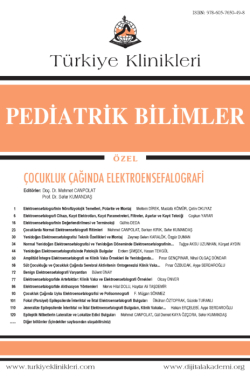Electroencephalography Findings in Acute Encephalopathy
Sarenur GÖKBENa, Seda KANMAZa
aÇocuk Nörolojisi BD, Ege Üniversitesi Tıp Fakültesi, İzmir, TÜRKİYE
Gökben S, Kanmaz S. Akut ensefalopatide elektroensefalografi bulguları. Canpolat M, Kumandaş S, editörler. Çocukluk Çağında Elektroensefalografi. 1. Baskı. Ankara: Türkiye Klinikleri; 2019. p.147-56.
ABSTRACT
Acute encephalopathy is a common pediatric emergency during childhood. Although different new modalities have been developed for the evaluation of cerebral functions, electroencephalography (EEG) still has most frequently used method. EEG changes observed in acute encephalopathy are as follows; background changes, periodic discharges, rhythmic discharges, interictal epileptiform discharges, ictal epileptiform discharges. Accurate identification of these changes is determinative in terms of clinical approach, choice of treatment and the prediction of the final outcome. In this article, EEG changes in acute encephalopathy are reviewed.
Keywords: Electroencephalography; brain diseases; coma; status epilepticus
Kaynak Göster
Referanslar
- Bazaraa HM, El Houchi S, Rady HI. Profile of patients visiting the pediatric emergency service in an Egyptian university hospital. Pediatr Emerg Care. 2012;28(2):148-52. [Crossref] [PubMed]
- Lanetzki CS, de Oliveira CA, Bass LM, Abramovici S, Troster EJ. The epidemiological profile of Pediatric Intensive Care Center at Hospital Israelita Albert Einstein. Einstein (Sao Paulo). 2012;10(1):16-21. [Crossref] [PubMed]
- Rady H. Profile of patients admitted to pediatric intensive care unit, Cairo University Hospital: 1-year study. Ain-Shams J Anaesthesiol. 2014;7(4):500. [Crossref]
- Young GB. The EEG in coma. J Clin Neurophysiol. 2000;17(5):473-85. [Crossref] [PubMed]
- Topjian AA, Gutierrez-Colina AM, Sanchez SM, Berg RA, Friess SH, Dlugos DJ, et al. Electrographic status epilepticus is associated with mortality and worse short-term outcome in critically Ill children. Crit Care Med. 2013;41(1): 215-23. [Crossref] [PubMed] [PMC]
- Jette N, Claassen J, Emerson RG, Hirsch LJ. Frequency and predictors of nonconvulsive seizures during continuous electroencephalographic monitoring in critically Ill children. Arch Neurol. 2006;63(12):1750-5. [Crossref] [PubMed]
- Abend NS, Wusthoff CJ, Goldberg EM, Dlugos DJ. Electrographic seizures and status epilepticus in critically ill children and neonates with encephalopathy. Lancet Neurol. 2013;12(12): 1170-9. [Crossref] [PubMed]
- Herman ST, Abend NS, Bleck TP, Chapman KE, Drislane FW, Emerson RG, et al. Consensus statement on continuous EEG in critically ill adults and children, part II: personnel, technical specifications, and clinical practice. J Clin Neurophysiol. 2015;32(2):96-108. [Crossref]
- Abend NS, Chapman KE, Gallentine WB, Goldstein J, Hyslop AE, Loddenkemper T, et al. Electroencephalographic monitoring in the pediatric intensive care unit. Curr Neurol Neurosci Rep. 2013;13(3):330. [Crossref] [PubMed] [PMC]
- Jette N, Claassen J, Emerson RG, Hirsch LJ. Frequency and predictors of nonconvulsive seizures during continuous electroencephalographic monitoring in critically Ill children. Arch Neurol. 2006;63(12):1750-5. [Crossref] [PubMed]
- Ramachandrannair R, Sharma R, Weiss SK, Cortez MA. Reactive EEG patterns in pediatric coma. Pediatr Neurol. 2005;33(5):345-9. [Crossref] [PubMed]
- Hirsch LJ, LaRoche SM, Gaspard N, Gerard E, Svoronos A, Herman ST, et al. American clinical neurophysiology society's standardized critical care EEG terminology. J Clin Neurophysiol. 2013;30(1):1-27. [Crossref]
- Wilson JA, Nordal HJ. EEG in connection with coma. Tidsskr Nor Laegeforen. 2013;133(1): 53-7. [Crossref] [PubMed]
- Kaplan PW, Rossetti AO. EEG patterns and imaging correlations in encephalopathy: encephalopathy part II. J Clin Neurophysiol. 2011;28(3):233-51. [Crossref] [PubMed]
- Kaplan PW. EEG monitoring in the intensive care unit. Am J Electroneurodiagnostic Technol. 2006;46(2):81-97. [Crossref] [PubMed]
- Andraus ME, Andraus CF, Alves-Leon SV. Periodic EEG patterns: importance of their recognition and clinical significance. Arq Neuropsiquiatr. 2012;70(2):145-51. [Crossref] [PubMed]
- Fitzpatrick W, Lowry N. PLEDs: clinical correlates. Can J Neurol Sci. 2007;34(4):443-50. [Crossref] [PubMed]
- de la Paz D, Brenner RP. Bilateral independent periodic lateralized epileptiform discharges. Clinical significance. Arch Neurol. 1981;38(11):713-5. [Crossref] [PubMed]
- Johnson EL, Kaplan PW. Population of the ictal-interictal zone: the significance of periodic and rhythmic activity. Clin Neurophysiol Pract. 2017;2:107-18. [Crossref] [PubMed] [PMC]
- Kaplan PW. The EEG in metabolic encephalopathy and coma. J Clin Neurophysiol. 2004;21(5):307-18.
- Hussain E, Nordli D. EEG patterns in acute pediatric encephalopathies. J Clin Neurophysiol. 2013;30(5):539-44. [Crossref] [PubMed]
- Kaplan PW. EEG criteria for nonconvulsive status epilepticus. Epilepsia. 2007;48 Suppl 8:39- 41. [Crossref] [PubMed]
- Lai CW, Gragasin ME. Electroencephalography in herpes simplex encephalitis. J Clin Neurophysiol. 1988;5(1):87-103. [Crossref] [PubMed]

